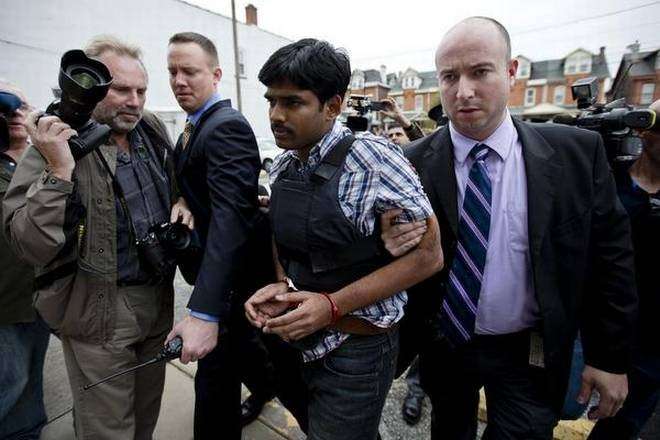August 27, 2017
CORPUS CHRISTI, Texas — Harvey spun deeper into Texas and unloaded extraordinary amounts of rain Saturday after the once-fearsome hurricane crashed into vulnerable homes and businesses along the coastline in a blow that killed at least one person and injured up to 14.

August 27, 2017
CORPUS CHRISTI, Texas — Harvey spun deeper into Texas and unloaded extraordinary amounts of rain Saturday after the once-fearsome hurricane crashed into vulnerable homes and businesses along the coastline in a blow that killed at least one person and injured up to 14.

Jennifer Bryant looks over the debris from her family business destroyed by Hurricane Harvey on Aug. 26, 2017, in Katy, Texas. Harvey rolled over the Texas Gulf Coast on Saturday, smashing homes and businesses and lashing the shore with wind and rain so intense that drivers were forced off the road because they could not see in front of them.
Throughout the region between Corpus Christi and Houston, many people feared that toll was only the beginning. They did not know the full scope of damage already done, and they dreaded the destruction that was yet to come from a storm that could linger for days and unload more than 40 inches of rain on cities, including dangerously flood-prone Houston, the nation's fourth-largest.
Long after the system came ashore, weather conditions prevented emergency crews from getting into many of the hardest-hit places. In the island community of Port Aransas, population 3,800, officials were unable to fully survey the town because of "massive" damage. Police and heavy equipment had only made it into the northernmost street.
Mayor Charles Bujan had few other details. "I can tell you I have a very bad feeling and that's about it," he said.
Some of the worst damage appeared to be in Rockport, a coastal city of about 10,000 that was directly in the storm's path. The mayor said his community took a blow "right on the nose" that left "widespread devastation," including homes, businesses and schools that were heavily damaged. Some structures were destroyed.
Rockport's roads were a mess of toppled power poles. A trailer blocked much of one major intersection. Pieces of 100-year-old oak trees impeded the slow passage of emergency vehicles. Wood framing from ripped-apart houses was strewn along Route 35 on the town's southern end.
Harvey's relentless wind tore the metal sides off the high school gym and twisted the steel door frame of its auditorium. The windows of some police vehicles had been blown out. "We're still in the very infancy stage of getting this recovery started," said Larry Sinclair, the Aransas County spokesman. Rockport Mayor Charles "C.J." Wax told The Weather Channel that the city's emergency response system had been hampered by the loss of cellphone service and other forms of communication.
On Friday, Rockport Mayor Pro Tem Patrick Rios offered ominous advice, telling the station that people who chose not to evacuate should mark their arm with a Sharpie pen, implying that the marks would make it easier for rescuers to identify them. Citing a county judge, the Austin American-Statesman reported one death from Harvey in Rockport, and 12 to 14 people injured.
In Port Aransas, the mayor had called for a mandatory evacuation and said he knew some people had stayed, but he did not know how many.
Elsewhere in the storm's immediate aftermath, Coast Guard helicopters rescued 18 people from boats and barges in distress, said Capt. Tony Hahn, commander of the Corpus Christi sector. The city's port was closed and will need a lot of repairs before it can reopen.
Because Corpus Christi is the third-largest petrochemical port in the nation, authorities will also be on the lookout for spills, Hahn said.
The fiercest hurricane to hit the U.S. in more than a decade came ashore late Friday about 30 miles (48 kilometers) northeast of Corpus Christi as a mammoth Category 4 storm with 130 mph (209 kph) winds. By dawn, nearly 300,000 consumers were without power in the coastal region, and nearly 20 inches (0.5 meters) of rain had fallen in some places.
Harvey weakened to a tropical storm by early afternoon. At 4 p.m., its maximum sustained winds had fallen to about 65 mph (104 kph). The storm was centered about 60 miles (97 kilometers) southeast of San Antonio. It was moving north at 2 mph (3 kph), the hurricane center said.
The hurricane posed the first major emergency management test of President Donald Trump's administration. Trump met with his Cabinet and other senior administration officials to discuss the federal response to the damage and flooding, the White House said Saturday in a statement.
The president held a video conference from Camp David in which he instructed relevant departments and agencies to "stay fully engaged and positioned to support his number one priority of saving lives," the statement said. Trump, who on Friday signed a federal disaster declaration for coastal counties, also reminded department heads that the full impact of the storm will not be apparent for days.
On Twitter, he commended the head of the Federal Emergency Management Agency for his handling of the disaster. In Corpus Christi, the major city closest to the storm's center, wind whipped palm trees and stinging sheets of horizontal rain slapped against hotels and office buildings along the seawall as the storm made landfall.
Daybreak revealed downed lamp posts and tree limbs and roof tiles torn off buildings. The city's marina was nearly unscathed, save an awning ripped from a restaurant entrance and a wooden garbage bin uprooted and thrown. Along Interstate 45 leaving Galveston, the rain was so intense that drivers were to stop under bridges because they could not see in front of them. In Houston, rain fell Saturday at nearly 3 inches (76.2 millimeters) an hour, leaving some streets and underpasses underwater. The many drainage channels known as bayous that carry excess water to the Gulf were flowing freely but rising.
"Flooding is a minor issue so far," Harris County Judge Ed Emmett, the chief administrator of the county that includes Houston, said. "Most of the watersheds are well within banks, but we're not out of this."
Francisco Sanchez, with the Harris County Emergency Management Office, said the storm would "linger a while." "Someone is going to get those very high rainfall totals," he said. "Hopefully it's not us, but we're in that possibility area."
About 4,500 inmates were evacuated from three state prisons in Brazoria County south of Houston because the nearby Brazos River was rising.
Fueled by warm Gulf of Mexico waters, Harvey grew rapidly, accelerating from a Category 1 early Friday morning to a Category 4 by evening. Its transformation from an ordinary storm to a life-threatening behemoth took only 56 hours, an incredibly fast intensification.
Harvey came ashore as the fiercest hurricane to hit the U.S. in 13 years and the strongest to strike Texas since 1961's Hurricane Carla, the most powerful Texas hurricane on record. The storm's approach sent tens of thousands of people fleeing inland. Families who escaped Rockport were worried about neighbors and whether their homes are still standing.
Johanna Cochran was panicking over whether her house or the McDonald's where she works survived the storm. She and her boyfriend evacuated to a San Antonio shelter. Another Rockport resident, Pamela Montes, said she knew many people who stayed behind because "no one felt like it was going to hit."
Just hours before landfall, the governor and Houston leaders issued conflicting statements on evacuation. Gov. Greg Abbott urged more people to flee, but Houston authorities recommended no widespread evacuations, citing greater danger in having people on roads that could flood and the fact that the hurricane was not taking direct aim at the city. The last Category 4 storm to hit the U.S. was Hurricane Charley in August 2004 in Florida.
Courtesy/Source: AP
















































































































